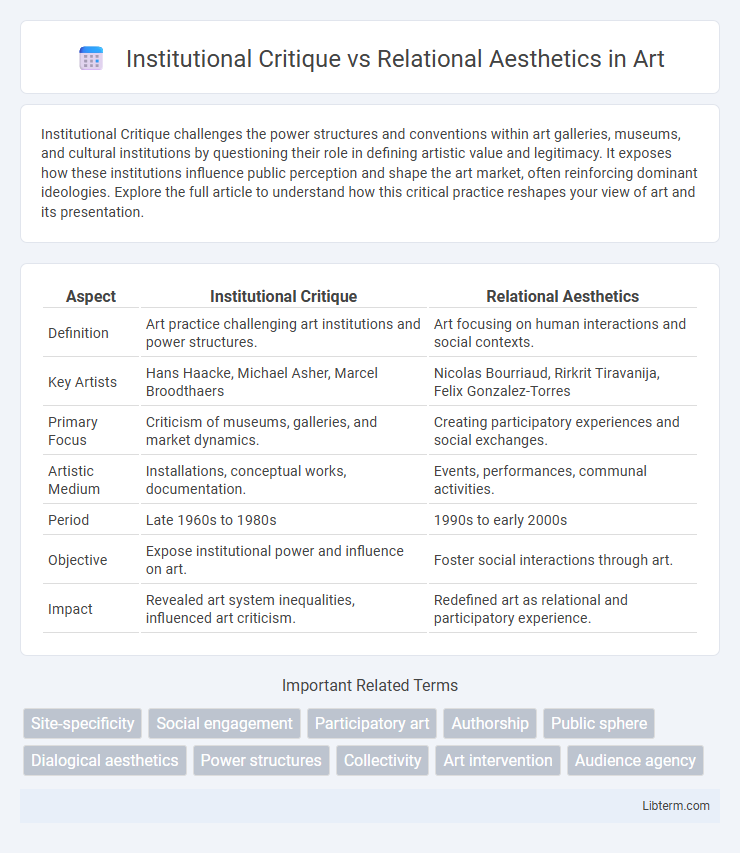Institutional Critique challenges the power structures and conventions within art galleries, museums, and cultural institutions by questioning their role in defining artistic value and legitimacy. It exposes how these institutions influence public perception and shape the art market, often reinforcing dominant ideologies. Explore the full article to understand how this critical practice reshapes your view of art and its presentation.
Table of Comparison
| Aspect | Institutional Critique | Relational Aesthetics |
|---|---|---|
| Definition | Art practice challenging art institutions and power structures. | Art focusing on human interactions and social contexts. |
| Key Artists | Hans Haacke, Michael Asher, Marcel Broodthaers | Nicolas Bourriaud, Rirkrit Tiravanija, Felix Gonzalez-Torres |
| Primary Focus | Criticism of museums, galleries, and market dynamics. | Creating participatory experiences and social exchanges. |
| Artistic Medium | Installations, conceptual works, documentation. | Events, performances, communal activities. |
| Period | Late 1960s to 1980s | 1990s to early 2000s |
| Objective | Expose institutional power and influence on art. | Foster social interactions through art. |
| Impact | Revealed art system inequalities, influenced art criticism. | Redefined art as relational and participatory experience. |
Defining Institutional Critique
Institutional Critique critically examines the power structures, policies, and socio-political frameworks that shape art institutions, exposing biases and hierarchies within museums, galleries, and funding bodies. This practice often involves artists intervening in or deconstructing institutional spaces to reveal underlying mechanisms of control and exclusion. Key figures like Hans Haacke and Andrea Fraser use their work to challenge the authority and legitimacy of art institutions, contrasting with the socially engaging and participatory focus of Relational Aesthetics.
Understanding Relational Aesthetics
Relational Aesthetics centers on artworks that create social interactions and community engagement, emphasizing experience over object permanence, distinguishing it from Institutional Critique which targets art world power structures. It focuses on participatory art practices that foster human relationships and collective meaning-making within specific contexts. This approach transforms the role of the spectator into an active participant, highlighting the social dynamics rather than the critique of institutional frameworks.
Historical Development of Both Movements
Institutional Critique emerged in the late 1960s and 1970s as artists like Hans Haacke and Michael Asher challenged the power structures and commercial interests of museums and galleries, emphasizing the politics of art institutions. Relational Aesthetics developed in the 1990s, pioneered by Nicolas Bourriaud, focusing on social interactions and audience participation within the art experience, reflecting a shift towards community and dialogue in contemporary art practices. Both movements critically respond to the context of art presentation but diverge in focus: Institutional Critique targets institutional frameworks, while Relational Aesthetics centers on interpersonal exchange and collective engagement.
Key Artists and Their Contributions
Institutional Critique is epitomized by artists like Hans Haacke, whose work exposes power structures within art institutions, and Marcel Broodthaers, who interrogated museum functions through conceptual installations. Relational Aesthetics is defined by figures such as Nicolas Bourriaud, who theorized the movement, and artists like Rirkrit Tiravanija, known for creating social interactions as art through shared experiences. These key artists significantly shaped their movements by challenging traditional art contexts and emphasizing viewer participation or systemic critique.
Artistic Strategies and Methods Compared
Institutional Critique employs strategies that expose and challenge power structures within art institutions by using site-specific interventions and critical reflection to reveal underlying socio-political dynamics. Relational Aesthetics focuses on creating interactive, participatory experiences that emphasize social engagement and collective meaning-making through collaborative and ephemeral methods. Both approaches disrupt traditional art object status but differ as Institutional Critique interrogates institutional authority, while Relational Aesthetics foregrounds interpersonal relationships and audience interaction.
Audience Engagement and Participation
Institutional Critique challenges traditional art venues by exposing and questioning power structures, often engaging audiences through reflective observation rather than direct participation. Relational Aesthetics prioritizes active audience involvement, creating interactive environments where social exchange and collective experience become the artwork's core. Both methodologies redefine the viewer's role, but Institutional Critique emphasizes critical awareness, while Relational Aesthetics fosters collaborative engagement.
Institutional Power Structures Explored
Institutional Critique interrogates the power dynamics within art institutions by exposing hierarchies and challenging traditional authority, often revealing how museums and galleries influence artistic value and cultural narratives. Relational Aesthetics emphasizes social interactions and communal experiences, focusing less on institutional critique and more on creating participatory environments that question the role of audience and artist collaboration. Both approaches explore institutional power structures, but Institutional Critique directly confronts systemic control, while Relational Aesthetics redefines power through the co-creation of meaning in social contexts.
Social Space and Relational Encounters
Institutional Critique interrogates social space by exposing power dynamics and the frameworks governing art institutions, prompting critical awareness of authority and cultural production. Relational Aesthetics centers on relational encounters, emphasizing interactive and participatory experiences that foster community and social bonds within shared spaces. Both methodologies engage social space but diverge in approach: one critiques existing structures, while the other constructs new social interactions.
Criticisms and Controversies
Institutional Critique faces criticism for its perceived elitism and reliance on deconstructing art institutions, which some argue limits accessibility and reinforces existing power structures. Relational Aesthetics is often contested for prioritizing social interaction over artistic autonomy, leading to accusations of superficiality and lack of lasting aesthetic value. Both approaches spark debate over the role of context and audience in defining contemporary art's purpose and effectiveness.
Impact on Contemporary Art Discourse
Institutional Critique challenges the power structures and conventions within art institutions, prompting artists and audiences to reconsider the role of museums and galleries in shaping art narratives, thereby fostering critical dialogue about authorship and commodification. Relational Aesthetics emphasizes social interactions and shared experiences as the core of art, shifting focus towards participatory practices that democratize art-making and blur boundaries between artist and audience. Together, these approaches have profoundly influenced contemporary art discourse by expanding the definitions of art and redefining the dynamics between creator, institution, and public.
Institutional Critique Infographic

 libterm.com
libterm.com